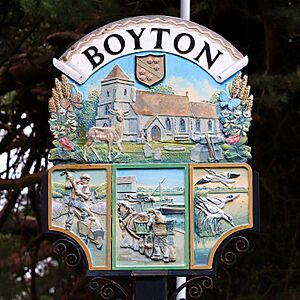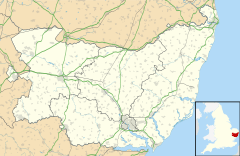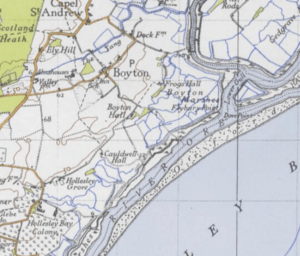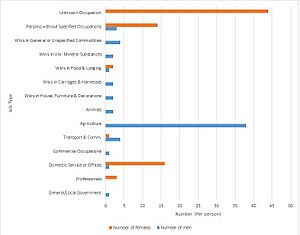Boyton, Suffolk facts for kids
Quick facts for kids Boyton |
|
|---|---|
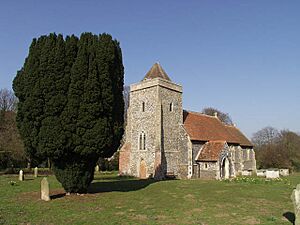 St. Andrew's, the parish church of Boyton |
|
| Area | 6.19 km2 (2.39 sq mi) |
| Population | 147 (2011) |
| • Density | 24/km2 (62/sq mi) |
| District |
|
| Shire county | |
| Region | |
| Country | England |
| Sovereign state | United Kingdom |
| Post town | Woodbridge |
| Postcode district | IP12 |
| EU Parliament | East of England |
| UK Parliament |
|
Boyton is a small village in Suffolk, England, located in the East Suffolk area. It's about eight miles east of Woodbridge and close to the famous Orford Ness. Boyton is part of England's beautiful heritage coast.
The village has a long history. In the Domesday Book of 1086, a very old record of England, Boyton was called "Bohtuna." The name 'Boyton' likely means "farmstead of the boys or servants." Today, Boyton has a primary school nearby for children aged 4 to 11, and its village hall is a busy place for community activities.
Contents
What is Boyton Like?
Boyton is a small place, covering about 6.6 square kilometers. Most of this land, about 6.2 square kilometers, is made up of "green space." This means it's open land without many buildings, often covered with grass, trees, or other plants, and usually open for everyone to enjoy.
Only a small part of Boyton's land, about 12.5 square kilometers, has homes and other buildings. Because there aren't many buildings, Boyton doesn't have a lot of people living close together. In 2011, there were only about 0.2 people per hectare. Boyton Road is the main road that connects the village to larger areas like Hollesley.
Boyton's History Through Time
Boyton has been home to people for a very long time, even as far back as 8,000 years ago! Back then, hunters visited the marshlands around Boyton. These areas were full of fish and wild birds, which the hunters would catch using nets, hooks, and tools made from flint.
There's lots of proof that people have lived in Boyton continuously. For example, a Bronze Age gold necklace, called a torque, was found here. You can see a copy of it at the Ipswich Museum, while the real one is at the British Museum.
Boyton is on the Suffolk coast, which was an important sea route. This means it might have been one of the first places where immigrants arrived in England many centuries ago. Digs in the North East part of Boyton have even found an important Anglo Saxon settlement.
Farming and Smuggling Days
For a long time, Boyton was mainly a farming and fishing village. People worked hard and the village was mostly self-sufficient. However, by the late 1700s, smuggling became common along the Suffolk coast, including in Boyton. Some local people who used to be honest farmers started working with smugglers.
After World War I, farming in Boyton faced tough times. Landowners started selling off their farms, like Valley Farm, Dock Farm, and Laurel Farm. But when World War II began, growing food at home became very important again, and farming picked up. During World War II, the Boyton area was even used as a tank training ground, and you can still see parts of old military buildings today.
Modern Boyton
In the 1970s and 1980s, some new houses were built in Boyton to help bring back a "community spirit." Sadly, the village shop and post office had closed by then.
A big change happened when the Royal Society for the Protection of Birds (RSPB) bought 175 acres of Boyton Marsh. This area includes Banter's Barn and Boyton Dock. This is great news for wildlife and for visitors who come to enjoy nature, and it also helps the village.
Jobs and Population Changes
In 1881, many people in Boyton worked in farming. Out of 61 men, 38 worked in agriculture. For women, many jobs were not officially recorded, perhaps because women often worked from home or in family businesses.
Around this time, farming across Britain faced a "Great Depression." Bad weather, especially a very wet year in 1879, meant crops didn't grow well. This caused problems for Boyton, as so many people relied on farming. This might be why Boyton's population started to drop towards the end of the 1800s.
Boyton's population has changed a lot over the years. In 1801, there were 201 people. The highest population was in 1851, with 320 people. However, in 2011, the population was at its lowest recorded level, with only 147 residents.
One reason for the population changes might be the decline of farming. In the 1800s, farming was a big industry, and even children often worked on farms, which could have led to a higher population. Today, Boyton's job market is more modern. In 2011, many residents were retired (35.3%), and only 21% worked full-time. The number of people working in public administration and defense was similar to those in agriculture, forestry, and fishing. This shift in jobs might mean that younger people move to bigger cities like London for more work opportunities.
Images for kids


